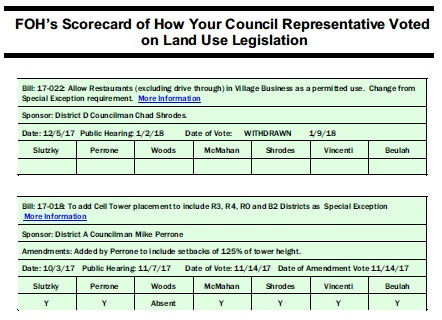Harford County Government published the following links on its website for information on hearing dates, how to participate virtually and where to watch County Council meetings and Zoning hearings. See Below
Category: Uncategorized
Legislative Scorecard UPDATE February, 2020
View the lastest Harford County Council legislative “scorecard” provided by Friends of Harford. Stay tuned for updates on land use legislation and track how your County Council representative voted!
NEW Proposed Legislation:
- Bill 20-001 Commercial Amusement and Recreation
- Sponsor: Council President Vincenti for County Executive Glassman
- Summary: Amends the Zoning Code adding COMMERCIAL AMUSEMENT AND RECREATION as a Permitted Use in the R4 Zoning District, subject to specified requirements regarding yard buffers, hours of operation, and allowable lighting sources. Plus, amendment introduced will increase hours of operation to 8 AM to 10 PM daily.
Read Bill Here
This bill is needed to support Resolution 001-20; a $1 sale of 25 acres Washington Court Surplus Property to Coppermine Fieldhouse, LLC; requiring the owning company to use land as an athletic field
facility for 20 years. This is not currently allowed in the R4 Zones. Read Resolution HERE.
Friends of Harford Opinion: Legislation should not be enacted County-wide for one company, owner or project. Rather, a use not permitted in a zoning district may be granted via a Special Exception as are Country and Swim Clubs, and Assembly Halls for example in R4.
Public Hearings: 2/4/20 6:15 pm
Friends of Harford will update the scorecard after the vote.
Harford County Legislative SCORECARD
Legislative Scorecard UPDATE December, 2019
Abingdon Business Park
Abingdon Business Park – Forest Stand Delineation and Forest Conservation Plan
In response to plans to create an industrial park on a 326-acre parcel near the Route 24 and Interstate-95 interchange, land use advocacy groups from Harford County and beyond signed a letter addressed to Mr. Brad Killian, Director of Planning and Zoning for Harford County.
The proposed Abingdon Business Park is located within Abingdon Woods bounded by I-95, Route 24, Route 7 and Abingdon Road. The legal and practical concerns include extensive deforestation (planned clear cut of 220 acres of forest) and potential for negative impacts to water quality are detailed in the full letter printed below.
The letter begins…
“The undersigned citizens and organizations are writing in opposition to the proposed Abingdon Business Park, located at the southeast corner of I-95 and Route 24. The undersigned have serious legal and practical concerns about the extensive deforestation proposed under the current plan and the associated negative impacts to water quality. This project proposes substantial deforestation that appears to violate local and state laws regarding forest conservation and is contrary to County policy as stated in the County’s Green Infrastructure Plan.” READ LETTER Continue reading “Abingdon Business Park”
Auston Pyrolysis Decision

The Harford County Circuit Court upheld the decision in Case 5886 to deny the tire pyrolysis operation by Auston Transfer and Processing on 6 acres in Joppa off Route 7.
The property, Auston Transfer, used for shredding and recycling scrap tires requested a new system to incinerate tires within a closed chamber. The property is zoned CI- Commercial Industrial. Planning & Zoning approved the use in this zoning category.
Within the time frame allowed, two Joppa citizens appealed the determination made by the Director and asked that the matter be reviewed by the County’s Hearing Examiner. They were assisted by the People’s Counsel. That decision was appealed because it considered the determination of the Planning and Zoning Director to allow this use in CI, was improper and that the pyrolysis system belonged in GI-General Industrial zoning.
As of this decision, the Hearing Examiner, County Council and now the Circuit Court all agree that the Director of Planning & Zoning overreached his authority and made a “legal error” in deciding to allow this use in CI.
In addition, the Circuit Court added that material and information which is not in the Zoning Code itself, should be made available to the public. In this case it was the Industrial Codes used by the Department of Planning & Zoning.
Why is this relevant?
Friends of Harford is sharing news of this decision because it is an example of how the system is supposed to work. The community had concerns about the potential for negative effects to the environment and of the proximity of the tire burning near their homes. At each level, the facts were brought to light and the decision was made not to allow this type of facility in a Commercial Industrial Zoning. Had the tire pyrolysis plant been allowed in CI, it would have set precedent for future types of facilities in CI zoning.
Zoning Changes Update & New Scorecard
Friends of Harford News and Views
June, 2019
Bill 19-016 – Zoning Code Changes- Public Hearing Input- June 4, 2019
Recently, Friends of Harford President, Stephanie Flasch provided public input on Bill 19-016 (Zoning Code Changes) See full text of comments here.
See full text of Bill 19-016 HERE.
There is still time for citizens to send their comments to the County Council.
Call or email the County Council at (410) 638-3343 or council@harfordcountymd.gov
Friends of Harford tracks the voting records for land use legislation via the SCORECARD. The Friends of Harford scorecard will be updated with amendments and voting record for land use legislation.
2018 Candidates Responses to FoH Questions on Land Use
In anticipation of the upcoming election, Friends of Harford asked Harford County Candidates for County Executive and County Council to please respond to the following questions so that we may understand their perspectives and reasoning on land use issues. The candidates’ responses can be found here.
Friends of Harford Annual Meeting-April 29th
 Everyone is invited to the Friends of Harford Annual meeting Sunday, April 29 from 1:30 to 4:40 p.m. at the Abingdon Library, 2510 Tollgate Road. Due to the recent comprehensive zoning, changes in land use for your neighborhood will be explained and we will explore… What Could Happen NEXT?
Everyone is invited to the Friends of Harford Annual meeting Sunday, April 29 from 1:30 to 4:40 p.m. at the Abingdon Library, 2510 Tollgate Road. Due to the recent comprehensive zoning, changes in land use for your neighborhood will be explained and we will explore… What Could Happen NEXT? Mixed Use In Your Backyard
The term “Mixed Use” is the basic principle of integrating where we live, work and shop and allows for various configurations and densities.
The Harford County Zoning code §267-76, amended August 22, 2016 permits Mixed Use Centers* in every business, commercial and industrial zoning and in the high density R4 zoning. All that is required is 5 acres of land inside the development envelope with access to a primary road and access to public water and sewer. Except for rubble fills, every use permitted in B1, B2, B3, CI, GI, LI and R4 zoning districts are permitted in the Mixed Use District REGARDLESS OF THE UNDERLYING ZONING.
This means that properties intended to have low-intensity B1 zoning can be used at higher intensity, or for large commercial and industrial facilities, without public input, by establishing a Mixed Use District.
B1 Neighborhood Business District is intended to provide limited retail services convenient to residential neighborhoods near the permitted business. B1 has standards which are compatible with low-density residential districts.
We believe zoning code §267-76, should be amended to remove B1 areas from this use.
We believe it is wrong to allow high intensity, high impact, and high traffic industrial and business uses in what is supposed to be low-impact B1 zoning
(i.e., limited retail and service facilities for nearby residences). We believe Mixed Use Centers should not be allowed on properties zoned B1.
The concept of a mixed use center that creates a combination of business and residential uses and a reduction of vehicle miles traveled is a good concept. But Mixed Use Center should not enable developers to supersede low-intensity B1 zoning standards, in effect rezoning properties to higher intensity without public input.
We urge you to contact the County Council and ask them to amend the Zoning Code to remove Mixed Use Centers in B1 zoning districts.
*Mixed Use Centers are Special Development uses, meaning they are uses that are automatically allowed when they meet certain additional design requirements.
Review Harford County Zoning Code’s standards and descriptions HERE
Quickly compare the Uses permitted under different zoning, click HERE.
Allowable B1 zoning uses are on pages 18 and 19.




